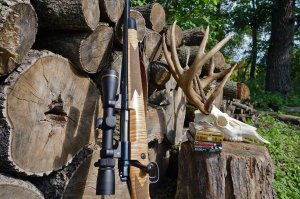We may earn revenue from the products available on this page and participate in affiliate programs. Learn More ›
During the 1980s, sporting rifle design took a mega-leap forward, and when it landed, it produced the superguns we take for granted today. This explosion of ingenuity came from four men: Lee Six and Chet Brown, who more or less simultaneously developed the synthetic stock; Kenny Jarrett, who brought benchrest-accuracy to big-game rifles; and Melvin Forbes, who gave us lighter rifles than anyone dreamed possible.
Both Lee Six and Chet Brown are gone (although Chet’s company, Brown Precision, is still building rifles, and fine ones at that) but Kenny and Melvin are still with us, and 2015 is the 30th anniversary of Melvin’s company, which began as Ultra Light Arms, and is now New Ultra Light Arms.
I met Melvin in 1986, and we’ve been friends since then. We’ve gone hunting more times than I can remember, and I’ve probably done more hunting with Ultralights than anything else. Keeping a gun company going is one of the more difficult things you can undertake (most don’t survive) and Melvin changed things forever, so it’s time to pay our respects.
The thing you have to understand about Melvin is, he’s a mechanical genius, and I don’t use that term lightly. He can pick any lock, fix any car, build a house in which everything works. I once asked him if he could make me a 5-string banjo, and he said that if I could get him one to copy off, it would be no problem. Probably he could make a cuckoo clock or an atom bomb if it became necessary.
In the early 1980s he had established himself as a country gunsmith, and was approached by a customer who had become lost in a Montana blizzard, and in order to make the walk out, had hung his heavy rifle in a tree.
“Build me a light rifle,” he said.
So Melvin did. Using a Remington 600 action, he came up with one that weighed a bit over 6 pounds without scope. And then he got to thinking. At the time, the standard weight for a big-game rifle was 9 to 10 pounds. A lightweight was 8 pounds with scope. The reason was that hunters simply accepted this, and that the major gunmakers were disinclined to make radical changes as long as what they were building sold. But Melvin looked hard and saw lots and lots of weight that had no function at all.
He closed down his gunsmith business, got a job teaching high school shop to support himself, and over two years, designed a new bolt-action. Superficially, it resembled a Remington 700, but if you looked closely, you saw all sorts of differences. The bolt handle was much smaller. The action was only as long as it had to be for a particular cartridge. The scope rings were aircraft aluminum, and were of one piece with the bases. Blind magazines were the rule. Barrels were Douglas’ No. 1 taper, and no longer than they had to be.
But the major weight saving was in the stock. It was the design of Melvin and two of his friends in the aerospace industry, the Glue Man and the String Man. It was a Kevlar/graphite composite, full-size, pillar-bedded, and weighed a pound even. You can run one over with a pickup truck and all you’ll do is scratch the paint. This is not theory; it’s been done.
His first completed rifle was a .308. It weighed 5 ¼ pounds. With scope, it went just under 6. And it would shoot with anything out there. The rest, as they say, is history.
I started buying Ultra Lights when I began hunting on an industrial basis. It wasn’t the light weight that attracted me but the accuracy and consistency of the rifles. Melvin spent 20 years repairing the mistakes of other designers, so he designed his rifle without bells and whistles, complications, or stresses. Once you figure out what an Ultra Light wants to shoot and sight it in, you’re done. That rifle will not budge no matter what you do to it.
Also, Melvin could tolerate my nonsense. Around 1989 I asked him to make me a 7mm Weatherby Magnum with a #3 contour 24-inch barrel and the stock painted vomit camo pattern. He delivered to me a yellowish paint job with green and brown blobs that was a true inanimate hideosity, but which turned out to be one of the most useful guns I’ve ever owned.
It went to Texas, and the Ungava Peninsula, and South Carolina, and Wyoming, and whatever I aimed it at fell down when I pulled the trigger.
At one time or another I’ve owned NULAs in .22 LR to .340 Weatherby, and you can get them up to .416 Rigby. But I think the best ones are made for small, mild-kicking cartridges such as .308, .257 Roberts, 7mm/08, 6.5 Swede, 7×57, and .250/3000. Melvin’s own rifle is a wildcat, a 6.5 Remington Magnum necked up to 7mm. It shoots 140-grain Noslers at 2,850 fps, and Melvin has shot everything with it.
NULAs are not cheap. They’re made by hand, and the list of optional features, including camo paint jobs, is endless. If you can’t break the budget for one, Forbes Rifles in Maine can supply you with essentially the same rifle minus all the options.
When I first met Melvin, I was struck by the way he spoke the words “not right.” He’d be talking about a factory rifle and say, “The bedding on that gun’s not right.” It had such horror and loathing in it you knew that this was a guy who could only live with himself if what he built was right. He’s been doing that for a quarter of a century, and it’s time to say thank you.
This post is dedicated to the memory of Mickey Coleman, retired insurance agent and gunsmith of Selma, Alabama, whom Melvin and I were proud to call our friend.
“His very breath was kindness.”

